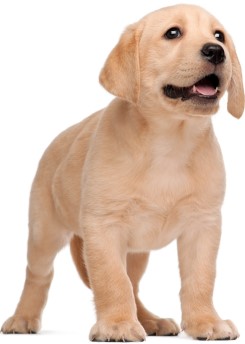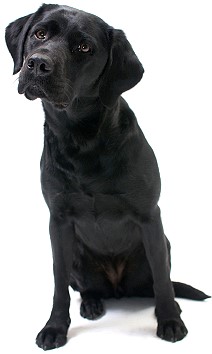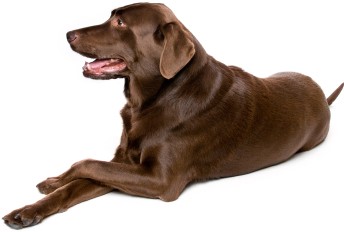|
 The Labrador Retriever The Labrador Retriever
(Updated 9-7-12)
According to the American
Kennel Club, the Labrador Retriever has been the most popular registered breed
of dog in the United States for the past decade. Obviously, the Lab makes an
ideal family pet due to their gentleness with children, easygoing personality,
intelligence, loyalty, and ease of training - not to mention good looks.
According to the AKC breed
standard, the lab has a "short, dense, weather resistant coat," and an "otter"
tail. We all know that they love water. The Labrador Retriever comes in yellow,
black, and chocolate coat colors. The breed standard allows for a small white
spot on the chest. A coloration known as "Dudley" is variously defined as
yellow Labradors which have unpigmented (pink) noses, yellow with liver or
chocolate pigmentation, or "flesh colored" in addition to having the same color
around the rims of the eye rather than having black or dark brown pigmentation.
Although they are the same breed origin, a distinction can be drawn between the
American Labrador and the British or English Labrador. American lines, having
been developed for hunting, are thought to be a bit larger and more aggressive
than their British cousins.
The Labrador Retriever
originated in Canada, but in Newfoundland rather than Labrador as one might
assume. It is possible that the breed might even have originated in Portugal.
The word Labrador means "laborer" in the Portuguese language. It is theorized
that Portuguese sailors could have introduced the dog to Newfoundland as early
as the 16th century. The breed developed on Newfoundland was called the "Saint
John's water dog" and were used by fishermen to retrieve lost nets from the
water. They lived at home with their human family, becoming at ease with
children.
The documented history of the
breed began in the early 19th century when some well-to-do folks from Great
Britain brought some St. John's dogs back to Poole, England. These dogs became
prized hunting dogs for waterfowl. Meanwhile, a combination Newfoundland's
sheep protection policy and England's rabies quarantine cut off the supply of
dogs from Canada. From there the original imports were used to create the
modern Labrador breed in the latter half of 19th century England. In fact, all
Labradors are considered to be descended from two imported St. John's dogs,
"Buccleuch Avon" and "Ned," given by the Earl of Malmesbury to the Duke of
Buccleuch to assist in his breeding program during the 1880s.
 The term
"Labrador" started to become a common name for the dog around 1865. The term
became popular in order to distinguish the Labrador Retriever from the larger
"Newfoundland" dog. The Labrador dogs were all black until the Duke of
Buccleuch bred the first liver colored labs in 1892. True chocolate labs did
not become common until the 1930s. The first yellow lab, "Ben of Hyde, was born
in 1899. The Labrador Retriever, as a breed, was formally recognized by the
English Kennel Club in 1903 and the American Kennel Club in 1917. A large
number of Labrador Retrievers were brought to the United States in the 1920s,
where they quickly gained in popularity through the 1930s. Key to their wider
recognition in the U.S. was an article in the American Kennel Gazette in 1928
titled Meet the Labrador Retriever. Back in Newfoundland, the St. John's Dog
became essentially extinct by the 1930s as a result of the island's economy
changing from fishing to sheep farming. The term
"Labrador" started to become a common name for the dog around 1865. The term
became popular in order to distinguish the Labrador Retriever from the larger
"Newfoundland" dog. The Labrador dogs were all black until the Duke of
Buccleuch bred the first liver colored labs in 1892. True chocolate labs did
not become common until the 1930s. The first yellow lab, "Ben of Hyde, was born
in 1899. The Labrador Retriever, as a breed, was formally recognized by the
English Kennel Club in 1903 and the American Kennel Club in 1917. A large
number of Labrador Retrievers were brought to the United States in the 1920s,
where they quickly gained in popularity through the 1930s. Key to their wider
recognition in the U.S. was an article in the American Kennel Gazette in 1928
titled Meet the Labrador Retriever. Back in Newfoundland, the St. John's Dog
became essentially extinct by the 1930s as a result of the island's economy
changing from fishing to sheep farming.
There are differences between
blood lines of Labradors that were bred for field trials and hunting, sometimes
referred to as "American," and those Labradors that were bred for the show ring
and as a family pet, sometimes referred to as "English" lines. Those dogs that
were bred for field-trial are selected first for their working ability. Dogs to
compete in conformation shows are selected first for their conformation to the
standards and characteristics sought by judges in the show ring. Individual
dogs of course vary, but in general the show dogs are heavier built, shorter,
and have a thicker coat and tail. Field dogs are generally longer in the legs,
lighter, and more agile. Hunting lines tend to be more energetic and
aggressive, while show dogs are thought to be calmer and might be more suited
to the role as family pet. While some field type breeders feel that breed shows
do not adequately recognize their type of dog, in the U.S. the AKC and the
Labrador's breed club have set the breed standard to somewhat accommodate the
field-bred Labrador. However, dual champions in both field trials and the show
ring are unusual.
Labrador Retrievers are
powerful swimmers noted for their ability to tolerate cold water for long
periods of time. The discipline that allows Labradors to stay quiet beside
hunters while watching for birds to fall from the sky, marking where they land,
and then using their outstanding nose to find and retrieve the target has made
them the top breed of waterfowl retrievers. Labradors are intelligent and excel
as working dogs. Statistics show that over 92% of Labradors who were tested
passed the American Temperament Test. Besides being a hunting breed, the Labs
are superb at tracking and detection, disabled assistance, and therapy work.
Between 60 and 70 percent of all guide dogs in the United States and Canada are
Labrador Retrievers. The Lab's nose and temperament also make them excellent
military working dogs in various roles like tracking, rescue, and bomb
detection.
In recent years the
"Labradoodle," a Labrador Retriever hybrid has become popular. The Labradoodle
is a "designer dog" that is a cross-bred Labrador and Poodle. A concept that
originated in Australia, the intent of breeding this cross was to try and
create a service dog suitable for allergy sufferers. Unfortunately, there is no
guarantee such a cross will inherit the hypo-allergenic poodle coat. Some
assistance-dog groups use Golden Retriever-Labrador Retriever hybrids because
they believe this cross produces dogs with excellent temperaments. The
assistance dog organization Mira utilizes Labrador-Bernese Mountain Dog crosses
("Labernese") with success.
The first dog to ever appear on
the cover of Life Magazine was a black Labrador Retriever named "Blind of Arden
in the December 12, 1938 issue. Here are a few other famous and noteworthy
labs: 
- " Zanjeer is a bomb detection dog who located arms and
ammunition used in the 1993 Mumbai (Bombay) serial explosions. During his
service, he helped recover 57 homemade bombs, 175 gasoline bombs, 11 military
grade armaments, 242 grenades and 600 detonators. His biggest contribution to
the police force and the city was the detection of over 7,000 pounds of RDX (a
type of explosive).
- " Lucky and Flo, twin black Lab counterfeit detection
dogs who became famous in 2007 for "sniffing out nearly 2 million pirated
counterfeit DVDs" on a six-month assignment to Malaysia in 2007. Following the
multi-million dollar, six-arrest Malaysian detection, they became the first
dogs to be awarded Malaysia's "outstanding service award" and software pirates
were stated to have put a £30,000 contract out for their lives.
- " Sabi, an Australian special forces explosives detection
dog that spent almost 14 months missing in action (MIA) in Afghanistan before
being recovered safe and well in 2009.
- " Former President of the United States Bill Clinton
owned two Labradors named Buddy and Seamus.
- " Russian President Vladimir Putin's Labrador is named
Koni.
- " Since 1972, a yellow Labrador pup known as the Andrex
Puppy has been an advertising symbol for Andrex (Cottonelle) toilet
tissue.
- " Michigan State University has an ongoing tradition of
"Zeke the Wonder Dog" who puts on a Frisbee catching show during the halftime
at Spartan football games. The original Zeke, as well as the current Zeke IV
was a yellow Lab, as Zeke III and Zeke II were black Labs.
Be sure to visit our Labrador Retriever Store
on Cafe Press » and enjoy a huge selection of Labrador
Retriever Gear in our
Zazzle Store »
Labrador Retriever photos ©
iStockphoto |






